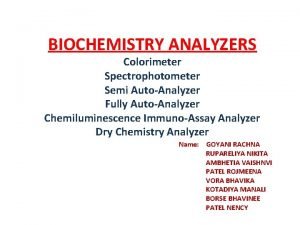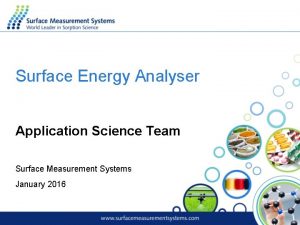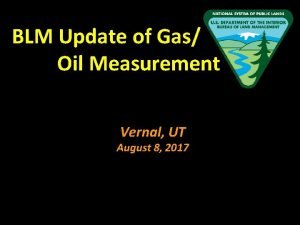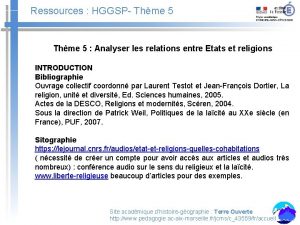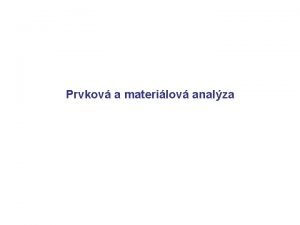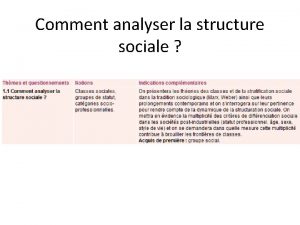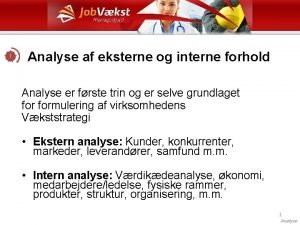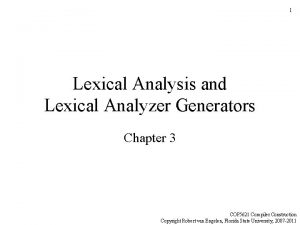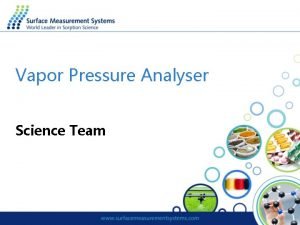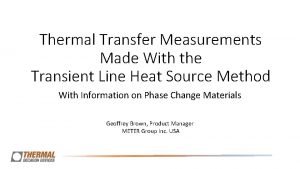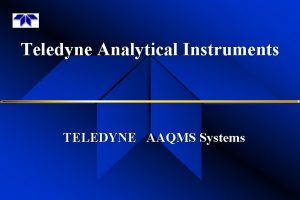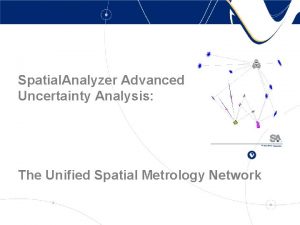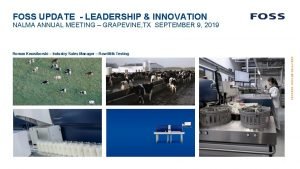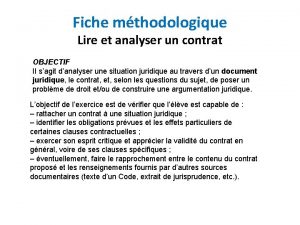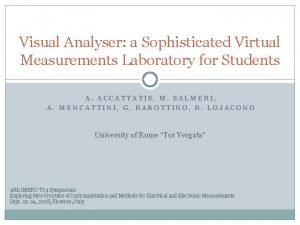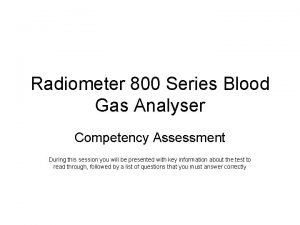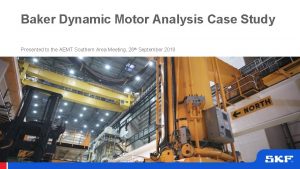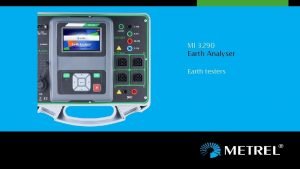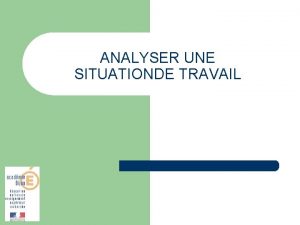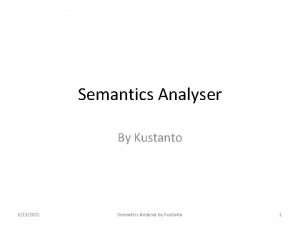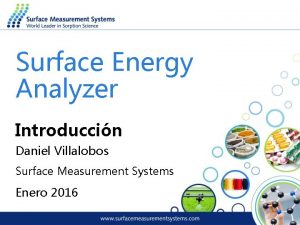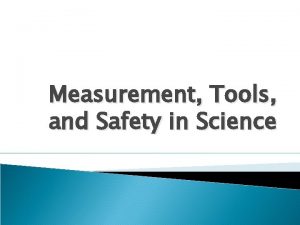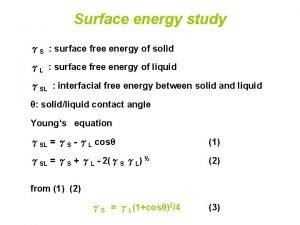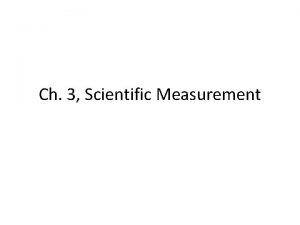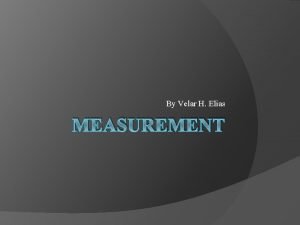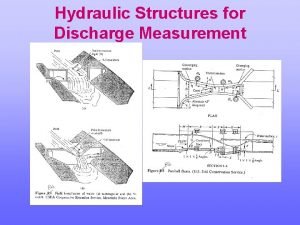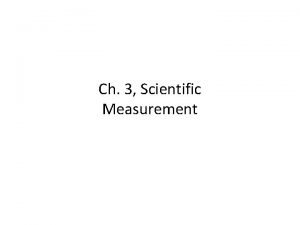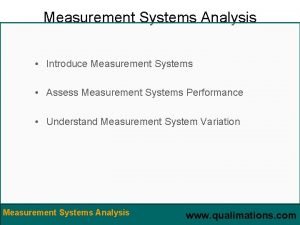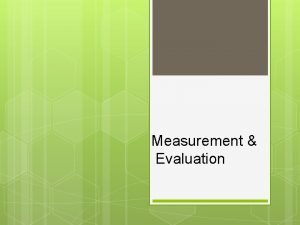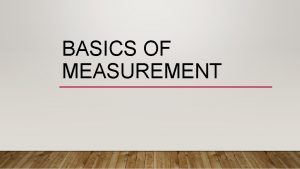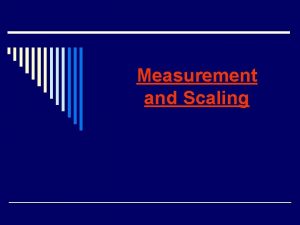Surface Energy Analyser Application Science Team Surface Measurement


































- Slides: 34

Surface Energy Analyser Application Science Team Surface Measurement Systems January 2016

Agenda • Inverse Gas chromatography technique • Concept • Principle • Surface Energy Analyser (SEA) • Introduction • Properties measured by the Instrument • Competitors Overview • Applications/Markets • Summary • Conclusions

Surface Energy Analyser by SMS. Based on the Inverse Gas chromatography technique (IGC) What is IGC…?

IGC History First publication discussing the technique dates from earlies 80’s. Nowadays, hundreds of publications about surface energy of polymers, catalyst, fibres, composites, APIs, etc can be found across different journals. Almost the all early studies used a home-build i. GC. - None produced i. GC that time. Since the invention of the Surface Energy Analyser (SEA), the IGC technique became commercially accessible in the form of an automated and fully controllable system Latest published SEA papers Ø Composite - Powder Technology 270 (2015) 112– 120 Ø Food - Food Chemistry 174 (2015) 25– 30 Ø Zeolite - Journal of Chromatography A, 1362 (2014) 250– 261 Ø Pharma - Pharm Res (2015) 32: 248– 259

Introduction Inverse Gas Chromatography (IGC) principles*: 1 st developed in 1950 s. “Inverse gas chromatography (IGC) is a versatile, powerful, sensitive and relatively fast technique for characterizing the physicochemical properties of materials. Due to its applicability in determining surface properties of solids in any form such as films, fibres and powders of both crystalline and amorphous structures, IGC became a popular technique for surface characterization…”

IGC Concept Mobile phase: Unknown Gas/Vapors Mobile phase Known Gas/Vapor Stationary phase: Known solid (Generally provided by Instrument Manufacturer) Stationary phase: Unknown solid. (Sample to characterize) Animation by L. Teng, Surface Measurement Systems

i. GC Principle Pack a column with the sample of interest Select probes Non-polar solvent for the dispersive interaction Polar solvents for the specific interactions Inject them at infinite and/or finite dilution From the retention time the different physicochemical properties can be determined

i. GC Principle cont. Pack a column with the sample of interest Sample Silane-treated glass tube 30 cm long & 6 mm O. D. 2, 3 & 4 mm I. D. 10 mg – 500 mg of material typically 0. 5 m 2 of surface area Glass wool

i. GC Principle cont. Select probes Non-polar solvent for the dispersive interaction Polar solvents for the specific interactions • New injection scheme: *1: 4000 Injection Ratio * Controlled by injection pulse (15 ms – 60, 000 ms) * Allows wider range of concentrations * Allows exact dosing of number of probe molecules 12 solvent reservoirs (2 drawers of 6 reservoirs each) Easy access drawers Temperature-controlled for vapor stability Fully automatic – up to 2500 injections in a sequence

i. GC Principle cont. Decane Nonane Inject them at infinite and/or finite dilution Octane Heptane 30% 60% 75% Surface Coverage

IGC Principle: Retention Time From the retention time the different physicochemical properties can be determined • Single pulse of probe molecule • t 0 is the retention time for an inert molecule (distribution coefficient KR = 0, CH 4, Ar, N 2 & H 2) • t. R is the retention time for the interacting probe • Net retention time t. N = t. R - t 0

Surface Energy Analyser by SMS. What is the SEA and what are the instrument specs?

SEA Introduction Our Surface Energy Analyser is the new generation of the inverse Gas Chromatography technique. It is specially designed to determine the surface energy heterogeneity but nevertheless suitable to measure different surface and bulk properties of solid materials such as Adsorption isotherms, Heat of sorption, Glass Transition Temperature, Solubility Parameters and so on. • Compact design – Small footprint: 450 mm (18”) x 700 mm (27. 5”) • 12 vapor reservoirs (50 ml) • 2 column oven design: 20 to 150 °C • Flame Ionization Detector (FID) • User Friendly Control and Analysis Software Safety Features: Hydrogen Leak & Organic Vapor Leak Detectors

SEA Variable Injection Scheme Solvent pulse sizes of greatest precision and range Reproducibility of i. GC SEA Instrument-to-Instrument: RSD 0. 69% (n>10) Experiment-to-Experiment: RSD 1. 20% (n>10) Column-to-Column: RSD 1. 00% hexane

Additional Features *Background Humidity Control: 0 to 90% RH (at 25 °C) Allows to run the experiments under real conditions *Film Cell – external bench-top unit Surface of film or plate can be measured with this accessory

Surface Energy Analyser by SMS. What properties can be measured by SEA?

Properties measured by SEA • Surface Energy Analysis • Dispersive, acid-base components & total surface energy Knowledge of surface energetics is • Acid-base Free Energy of Desorption Analysis important in the formulation design of • Heterogeneity Mapping multi-component • Heterogeneity profiles, heterogeneity distributions • Gutmann Acid/Base Properties • Isotherm Analysis • Peak Max, ECP tailing & fronting, Henry’s constant • BET Specific Surface Area • Thermodynamic Work of Adhesion/Work of Cohesion • Heat of Sorption • Bulk Solid Properties • Glass Transition Temperature • Solubility Parameter (Hildebrand 1 D, Hansen 3 D) • Cross-linking Density systems and the prediction of processing performance. The surface energy heterogeneity profile constitutes an energy map of the material surface and also allows prediction of product properties, in particular in formulation of blends, composites or coatings

What Does Surface Energy Affect?

Surface Treatment effects on Surface Energy Investigation the influence of the surface treatment • Modifying surface energy of different materials at will Waxing, coating, silylation, hydrogenation, adsorption, relaxation High SE Low SE oxygen plasma treatment, chemical etching, sand blasting

Surface Energy Analyser by SMS. Direct and Indirect competition

Competition: overview Direct Competitors • None. The only manufacturers making an automated IGC system Indirect Competitors (other techniques) • Home built IGC systems (modifying a Gas chromatographer) • Contact Angle technique • Atomic force Microscopy • Wetting Balance

Surface Energy Analyser by SMS. Industry, Market and common applications

Pharmaceutical Market/Applications • • Formulation or pre-formulation groups at large pharma companies Inhalation • • Powder properties extremely important to product performance Dedicated Inhalation drug delivery companies or inhalation groups within large pharma companies • Materials Characterization Groups or Physical Properties Groups • University Physical Pharmacy Groups 23

Pharmaceutical Market/Applications • Process-induced disorder • • Affects of milling/grinding/micronization Amorphous versus crystalline Product stability Energetic heterogeneity • Drug-Excipient Interactions • Works of Adhesion/Cohesion • Powder mixing/segregation/powder flow • Polymorph Characterization • Material properties • Surface acidity-basicity • Surface modification 24

Composites-Filler Market/Applications • Carbon Fibers • Aerospace, automotive, carbon fiber manufacturers • National/Government labs • Research institutes/universities • Natural Fibers • Research institutes/universities • Wood Composites • Research institutes/universities • Forestry Government labs • Nanotechnology • Nanocarbons, nanoclays, nano-cellulose • Research institutes/universities • National/government labs 25

Composites-Filler Market/Applications • Works of Adhesion/Cohesion • Use surface energy to predict and measure interaction between two surfaces • Surface Modification/Characterization • Chemical change surface groups to make surface more compatible • Long-term stability of surface groups • Aging of surface treatments • Effectiveness of surface coatings 26

Polymer Market/Applications • Large, multi-national chemical companies • i. e. Dow, Du. Pont, BASF • Most likely central analytic groups • Specialty polymer companies • Drug delivery groups/companies • Paint and coating companies 27

Polymer Market/Applications • Glass transition temperatures • • • Solubility parameters • • • Controlled release applications Polymer blends; penetration of dyes; supercritical fluids Degree of Crosslink • • • True surface Tg Tg as a function of RH Drug eluting stents; controlled release applications Curing of epoxies Surface Energy • • • Composites – works of adhesion/cohesion Coatings/Surface modification: chemical; mechanical; plasma Wood, fiber, nanofiller composites 28

Filtration Market/Applications • Large Filtration companies • Large Tobacco companies • Defence labs/National labs • Personal protection groups • Chemical warfare groups • University research groups • Membranes • Selective filtration 29

Filtration Market/Applications • Selective Filtration • Tailor surface chemistry/structure to preferentially adsorb/interact with one species over another • Tobacco • Filter unwanted chemical species (i. e. Carcinogens) and not flavor • Chemical Agents • Detect chemical warfare agents • Soldier and equipment protection from chemical warfare agents 30

Surface Energy Analyser by SMS. Summary

i. GC-SEA Sales Points - Hardware • 2 column position oven design - two samples can be prepared and can be run sequentially, automatically • No need for separate outgassing facilities, since this will be achieved by conditioning the sample in-situ by purging column with inert carrier gas • Easier column packing procedure due to the column is straight (compared to some home-built systems) • Precise and wide range of injectable amounts – vapor phase injection not liquid (as with manual injections)

i. GC-SEA Sales Points – Scientific Support • • • Customer Education is Paramount • Not always mainstream technique • Sample demonstration is common • Must make customer ‘comfortable’ with the technique and data • Utilize SMS Application Science Team Unique Applications • Only robust method to measure surface energy of powders, fibers, and particulates • Unique capability of measuring energetic heterogeneity of materials • Few techniques can actually determine solubility parameters (computational methods most commonly used) SMS World Leaders in IGC Theory, Instrumentation, and Applications • Dedicated IGC Applications Specialists • Two dedicated applications laboratories • Authors and co-authors on several peer-review journal articles per year • SMS presents research at several international meetings • Scientific support for lifetime of instrument 33

Conclusions • SEA – a versatile and sensitive gas phase sorption technique for the physicochemical characterization tool for powders, fibers, films, particulates, semi-solids • SMS are innovators and market leaders in the realm of Inverse Gas Chromatography applications and science. • More information on specific applications can be obtained by emailing science@surfacemeasurementsystems. com. Head Office: United States Office: Surface Measurement Systems, Ltd, NA 5 Wharfside, Rosemont Road 2125 28 th Street SW, Suite 1 London HA 0 4 PE, UK Allentown PA, 18103 Tel: +44 (0)20 8795 9400 Tel: +1 610 798 8299 Fax: +44 (0)20 8795 9401 Fax: +1 610 798 0334 Email: science@surfacemeasurementsystems. com
 Biochemical autoanalyzer
Biochemical autoanalyzer Mobile surface analyser
Mobile surface analyser My favorite subject is arabic
My favorite subject is arabic 43 cfr 3174
43 cfr 3174 %option noyywrap
%option noyywrap Bibliographie hggsp terminale
Bibliographie hggsp terminale Nabi cosmetics wikipedia
Nabi cosmetics wikipedia Comment analyser la structure sociale
Comment analyser la structure sociale Comment analyser la structure sociale
Comment analyser la structure sociale Interne og eksterne forhold
Interne og eksterne forhold Regex analyser
Regex analyser Solar opposite lesson analyser
Solar opposite lesson analyser Chapter 8 lesson 1
Chapter 8 lesson 1 Lcm particle analyser
Lcm particle analyser Cfa komax
Cfa komax What is lexical analyzer generator
What is lexical analyzer generator Vapour pressure analysers
Vapour pressure analysers Transient line source apparatus
Transient line source apparatus Teledyne analytical instruments
Teledyne analytical instruments Spatial analyzer software
Spatial analyzer software Bactoscan definition
Bactoscan definition Analyser un contrat
Analyser un contrat Analyser un document iconographique
Analyser un document iconographique Tabel univariat
Tabel univariat Spendanalyse
Spendanalyse Pascal hamann
Pascal hamann Visual analyser
Visual analyser Radiometer blood gas analyser
Radiometer blood gas analyser Transportmodeller og -analyser
Transportmodeller og -analyser Skf exp4000 dynamic motor analyser
Skf exp4000 dynamic motor analyser Energy energy transfer and general energy analysis
Energy energy transfer and general energy analysis Energy energy transfer and general energy analysis
Energy energy transfer and general energy analysis Going native project management
Going native project management Team spirit becomes team infatuation
Team spirit becomes team infatuation The white team cheers for the blue team, just like
The white team cheers for the blue team, just like
